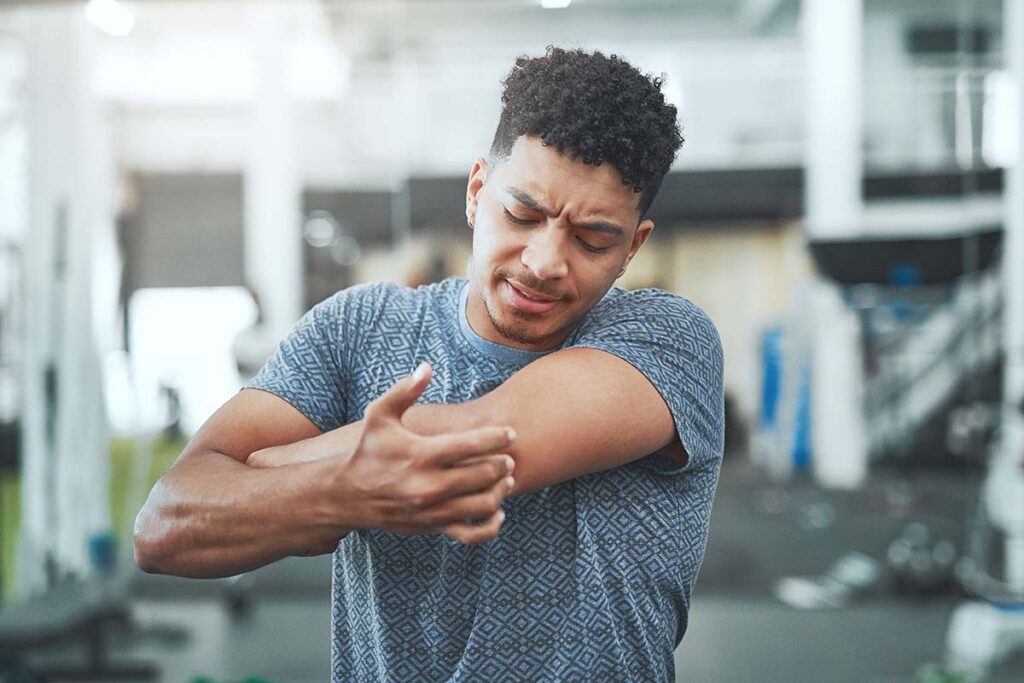It seemed like a good idea at the time. You hit the gym, climbed the hills, or ran too far too fast. Now, your overworked quads, glutes, and hamstrings are screaming, “Hey, wait up!” You’re in dire need of muscle recovery.
It happens. Your fitness goals are within reach. But your body’s overdue for a break. And it’s talking back … again! Is it time to throw in the workout towel? Not a chance! Fitness helps your heart, mind, and body. If you want to stay in the game and reduce the “ouch” factor, here’s a guide.
Brush up on these pre-workout basics and post-workout recovery tips. They’ll also help with sore muscle recovery if you overdo it. The endgame? Reaching your goals without burning out your muscles and your motivation.
Muscle Recovery Wisdom
“No pain, no gain,” is only true to a point. Overdoing it sets you back. It’s okay to feel mild soreness after a workout. When you work your muscles, microscopic muscle fibers break down. You’ll feel some discomfort. As muscle fibers rebuild, your muscles are getting stronger.
But if you push it, you can get tiny tears in your muscles. You’ll feel pain and inflammation. Flareups damage and weaken tissues. If you’re too sore, ease up.
When Muscle Pain = Doctor Visit
See your care provider if:
- Aches and pains persist, long after your workout
- Your muscle soreness or pain is getting worse
- You’ve started walking with a limp
- You feel pain during routine activities
Ignoring the signs can lead to sprains, strains, and sidelining injuries. Common setbacks include pulled hamstrings, shoulder strain, and Achilles heel, or other types of tendonitis (inflamed tendons). I’ve learned the hard way how damaging pushing through an injury can be. While tempting, you can make things way worse. And even end up needing surgery and sidelined for months.
Remember, the fundamentals still matter. For smoother recoveries, resist the urge to skip steps. Set aside plenty of time for important pre-workout warmups and post-workout cooldowns.
Before Your Workout
Ease into workout routines. Gradual warmups help your muscles, body, and heart rate get up to speed. To prevent muscle soreness and overuse injuries:
- Stretch before every workout. Stretching loosens tight muscles and joints, enhances flexibility, and improves your range of motion.
- Keep it simple. When warming up, you can run in place, go for a walk, or ride your exercise bike. You’re good to go after 5 to 10 minutes.
- Plan and pace your workouts. Health and fitness goals vary. Before starting a workout program, ask your care providers. They’ll make sure your plans suit your condition and goals.
Post-Workout Muscle Recovery
After a good workout, wind down gradually. Sudden stops are a shock to your body’s system. Your muscles, joints, heart, and lungs need time to adjust. Be sure to:
- Cool down and stretch after every workout. Stretching and gentle exercise shifts your body into recovery gear. Cooldowns ease your heart’s return to its resting rate and rhythm. They also ward off stiff muscles and muscle fatigue.
- Give your muscles a break. You and your body need a day or two off every week to rest and recover.
Sidelined by Injury?
UVA Health physical medicine & rehabilitation experts can help find the root cause and get you back to your workout.
How to Get Rid of Muscle Soreness
Before you reach for the medicine cabinet, try other approaches. Some of these sore muscle recovery options could be your new best friends:
- Foods. Muscle-friendly choices include protein-rich eggs, inflammation-taming tart cherry juice, or heart-healthy salmon. Pineapple and ginger also fight inflammation.
- Supplements. Magnesium reduces muscle soreness. Protein powders help your body rebuild and restore cells. Fish oil supplements treat muscle damage and inflammation. Nutritionists and other specialists can guide you toward safe, customized supplement choices. Popular options include turmeric, ginger, ashwagandha, chondroitin, and glucosamine.
- Stretching. Gentle stretches send healing blood to aching muscles and tendons. Simple upper and lower body stretches may take the edge off soreness.
- Ice or heat therapy. Cold therapy slows blood flow to relieve swelling and inflammation. Heat therapy speeds up circulation to treat tight, sore muscles.
- Ointments and creams. Where does it hurt? Apply creams, ointments, roll-ons, or sprays to hot spots. Cool menthol creams and other short-term therapies can make you say, “Ahhh.”
- Foam rollers. Gently roll this foam-covered tool over painful calves and other soft tissues. You’ll boost blood flow and remove some toxic metabolic acids. Try a softer roller at first and work up to firmer rollers.
- Muscle guns. These handheld wireless devices apply pulses to painful areas. They relieve muscle soreness and promote muscle recovery.
- Hot tub therapy. A 15-minute soak gets the blood flowing. Relaxing pulses loosen tight muscles and relieve soreness.
- Massage therapy. Massages make weary muscles happy. A massage therapist offers deep-tissue massage and other techniques to relieve pain. You can also self-massage aching arms and tender spots.
Play the Long Game
Whatever your fitness level or training goals, tune in to your body’s signals. To prevent post-workout soreness, ease up when you need to. Take time to take care of tender muscles before they get worse. Relaxing stretches and easy warmups and cooldowns make a difference. They’re simple steps that help you stay on track toward your long-term health and fitness goals.
